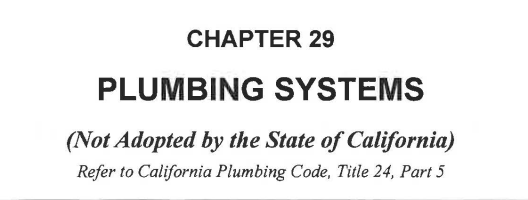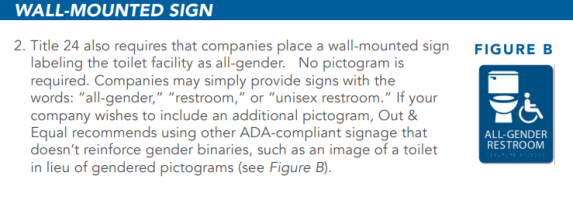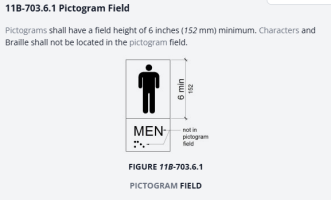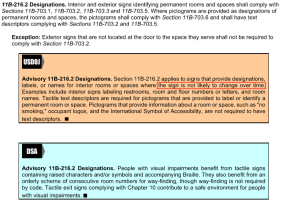The gender neutral, single user restroom issue in California provides us with a good code analysis exercise:
It all started in 2016 with Assembly Bill 1732 which created Health and Safety Code Section 118600, relating to the identification of single-user toilet facilities as all-gender toilet facilities.
Health and Safety Code Section 118600 requires:
(a) All single-user toilet facilities in any business establishment, place of public accommodation, or state or local government agency shall be identified as all-gender toilet facilities by signage that complies with Title 24 of the California Code of Regulations, and designated for use by no more than one occupant at a time or for family or assisted use.
(b) During any inspection of a business or a place of public accommodation by an inspector, building official, or other local official responsible for code enforcement, the inspector or official may inspect for compliance with this section.
(c) For the purposes of this section, “single-user toilet facility” means a toilet facility with no more than one water closet and one urinal with a locking mechanism controlled by the user.
(d) This section shall become operative on March 1, 2017.
ANALYSIS: To address identification of single-user toilet facilities as all-gender, in compliance with the accessibility provisions of California
Building Code (CBC) Chapter 11B. It is important to note that the clarification provided herein is not the result of a change in accessibility regulations, and is in accordance with existing accessibility requirements for symbols at entrances for toilet facilities, and wall-mounted designation signs if provided, as has been expressed adopted since the 2013 CBC.
1. The provisions of CBC Chapter 11B require that a sanitary facility that is not specifically identified as for "men" or "women" (referred to in Chapter 11B as a “unisex” facility) have a geometric symbol on the door that is an equilateral triangle superimposed onto a circle. The "unisex" symbol is the only specific indicator required to be provided by Chapter 11B or ADA for a toilet facility that is available for use by all individuals. No pictogram, text, or braille is required on the
symbol. (See attachment, Exhibit A.)
2. CBC Chapter 11B does not require a wall-mounted designation sign identifying a permanent room or space to be provided for a toilet facility. CBC Chapter 11B provisions for designation signs are conditional and the technical requirements apply only when a designation sign is provided.
According to CBC Chapter 11B, where a toilet facility is identified with a designation sign adjacent to the door, the sign is required to comply with the technical requirements for visual characters, raised characters, braille, and must also comply with other accessibility requirements for mounting height, clear floor space, and proximity to the door/entrance of the room. A pictogram is not required to be provided; however, where a facility owner elects to identify a toilet facility with a pictogram, a text descriptor consisting of visual characters, raised characters, and braille is required to accompany the pictogram.
Typically local jurisdictions do not have the authority to specify designation sign text, nor do they have the authority to regulate the image for a pictogram that is provided on a designation sign. The image of the pictogram and text descriptor is left to the discretion of the facility owner/operator. (See attachment, Exhibit B.)
The CBC requirements for use and application of designation signs are consistent with the 2010 Americans with Disabilities Act Standards (2010 ADAS).
The enforcement provisions contained in the statute: HSC §118600 states: "an inspector, building official, or other local official responsible for code enforcement, the inspector or official may inspect for compliance."
The following guidelines for demonstrating compliance might include the following:
For projects submitted for permitting since March 1, 2017: Provision of the "unisex"
geometric symbols (triangle superimposed on circle) mounted on the door are required. Indicate that the geometric signs be provided without text, braille, or use of a pictogram. If the designer wishes, voluntarily, to include a wall-mounted designation sign, the wall mounted sign provided at the single-user toilet facility, the sign to be specified in the construction documents, and to be indicated as a designation sign [CBC 11B-216.2] with raised text, corresponding braille. No pictogram is required, and due to the ambiguity and controversy around which pictogram, to select, it is suggested to omit a pictogram from the sign. Note however, that if the subject toilet room is the designated accessible restroom serving persons with disabilities in lieu of other nearby non-wheelchair accessible restrooms, an ISA symbol must be provided at the accessible toilet room and may be included on the wall mounted sign, or separately [CBC 213.2 Exception 1].
For single-user toilet facilities in projects are under construction, and existing single-user toilet facilities requiring a change of identification symbols:
When changing identification symbols of existing single-user toilet facilities from gender-specific to all-gender, the California Division of the State Architect (DSA) advises against providing a pictogram to represent an all-gender image on a either wall mounted designation signs or door mounted unisex geometric symbol signs. The pictogram could foreseeably be perceived as inappropriate, and in fact, DSA reminds facility owners that a pictogram is not required by code.
Door mounted geometric symbol signs are required by CBC 11B-216.8 to identify an all-gender/unisex single-user toilet facility. The symbol must comply with the requirements of CBC 11B-703.7.2.6.3. No pictogram, text, or braille is required on the symbol.
Wall mounted room designation signs are not required to be provided by the CBC or the 2010 ADAS. If provided, a designation sign adjacent to the door must comply with the scoping requirements of CBC 11B-216.2, and the technical requirements for raised characters (CBC 11B-703.2), braille (CBC 11B-703.3), visual characters (CBC 11B-703.5), and requirements for installation height and location (CBC 11B-703.4). Note that no pictogram is required by either ADA or CBC.
SOURCE INFORMATION: DSA Bulletin BU 17-01; 2022 CBC - Title 24 CCR; 2010 ADA - 36 CFR 1191, Appendices B & D; California Statutes.
Cheers, Craig Williams, CASP #005, Architect 22642, ICC Plans Examiner / Inspector #8405912




